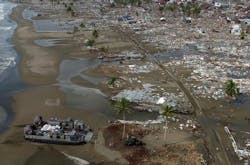ASCE issues first tsunami-safe building standards
By Peter Fabris, Contributing Editor
For the first time in the U.S., national construction standards will address the risk of tsunamis.
The American Society of Civil Engineers has developed a new edition of ASCE 7-16, the first to include a chapter on tsunami hazards, in addition to chapters on seismic, wind, and flood hazards. The tsunami standards are only for steel-reinforced concrete buildings in “inundation zones.” They will not apply to wood-frame structures.
The committee that developed the new standard began work in late 2010, a few months before the March 2011 earthquake and tsunami that devastated Japan.
“We weren’t reacting,” according to Dan Cox of Oregon State University, a professor of civil and construction engineering in the OSU College of Engineering, and one of about 20 engineers on the ASCE committee that developed them. “We were trying to do this in advance. After the 2011 event, interest accelerated regarding how to build things safely in a tsunami zone, and it was important that the subcommittee contained people familiar with how codes work and academic researchers who can bring in the latest advances.”
The tsunami standards will have the most impact on engineers designing and building structures less than about five stories in height. Above five stories, even-stronger building codes will take precedence over codes to protect smaller structures from tsunamis. The new standards can also be used on retrofit projects.
